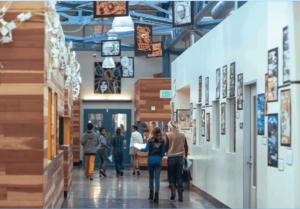Mastery Learning in Action

School and course designs aren’t one-way streets. They aren’t linear processes. They take into account a number of outcomes and design principles all of which is deeply grounded in the research on learning. That’s why there isn’t one way to do personalized, mastery learning. That’s why there isn’t a guide that gives you the 10 steps to transform your schools (although the recent release of Deeper Competency-Based Learning by Hess, Colby, and Joseph will provide plenty of insights).
There have been plenty of case studies developed at CompetencyWorks, Getting Smart, and Mastery Transcript Consortium. Each can be really helpful in looking at how and why a school design developed and some of the considerations in putting all the pieces together (or understanding why they didn’t fall into place easily). However, what the field has needed is resources that will let you see different types of design choices and the implications of each. Do you want to build your learning framework around competencies or standards? Do you want to maintain academic silos in your courses or move to interdisciplinary studies?
However, there have been a few resources to support schools in thinking through their choices. Making Mastery Work: A Close-Up View of Competency Education by Priest, Rudenstine, and Weisstein, was the first paper produced in this phase of competency education and drew from multiple schools. Breaking with Tradition by Stack and Vander Els also offers insights from a variety of schools. Mastery Learning in Action published by the Mastery Transcript Consortium offers a comparative structure based on visits and interview from 5 schools (the links below will take you to the case studies of each):
- Pathways High School
- Champlain Valley Union High School
- Tilton School
- Northern Cass School District #97
- Singapore American School
The paper was written pre-pandemic which means it doesn’t include how these schools adopted remote learning. The paper was also written before the uprising to address racial discrimination in the police and justice system and to cleanse our nation of its white supremacy roots. Everything looks different through these two lenses.
Pathways High School with its philosophy of ‘diversity by design’ and its clear understanding that to overcome educational disparity schools need to be organized around success not ranking will be helpful to any school thinking about what it needs to do to sweep out racist practices from every corner of its operations. Northern Cass, in the fields outside of Fargo, also offers insights into how to move beyond the ranking processes that reinforce concepts of superiority with their emphasis on every person discovering their ‘greatness.’
We need more of these kinds of papers and more conversations that look across design choices and practices to understand how the pieces fit together and how they build schools that can be more adaptive and more flexible in providing services to students in a variety of settings. Most of all, we need to take much harder look at the policies and practices that reinforce racial inequity in schools and the ideas that support them.
For more, see:
- Getting Smart on Mastery Learning
- Podcast: Scott Looney on Growing the Mastery Transcript Consortium
- Getting Started with Design Thinking
Stay in-the-know with innovations in learning by signing up for the weekly Smart Update.








0 Comments
Leave a Comment
Your email address will not be published. All fields are required.